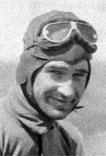 Otto Walker was a leading racer of the 1910s and early 1920s and was one of Harley-Davidson’s first factory riders. He won the first major race for the company, an FAM 300-mile road race in Venice, California, in April of 1915. Walker set numerous speed records during his eight-year professional racing career. He earned the distinction of being the first rider to win a motorcycle race at an average race speed of over 100 mph in 1921.
Otto Walker was a leading racer of the 1910s and early 1920s and was one of Harley-Davidson’s first factory riders. He won the first major race for the company, an FAM 300-mile road race in Venice, California, in April of 1915. Walker set numerous speed records during his eight-year professional racing career. He earned the distinction of being the first rider to win a motorcycle race at an average race speed of over 100 mph in 1921.
Walker was born in Lathrop, California, in 1890. He began racing as an amateur in 1911. The first time he won a race, the prize was a live turkey. By 1913, he was the top amateur on the West Coast, winning the Western Federation of Motorcyclists championships. During his amateur days, Dudley Perkins and Erle Armstrong were often his travel partners as the trio went up and down the coast, racing in fairgrounds dirt tracks and on board circuits all over California.
By 1914, Harley-Davidson was just getting into competition and sponsored Walker. By the end of that season he turned pro. Walker’s pro career had no so sooner started when he was injured in a crash and was forced to sit out the rest of 1914.
Even with his success as an amateur, Walker was little known beyond the West Coast. That all changed on April 4, 1915. On that day, Walker gave Harley-Davidson its first national victory when he won the 300-mile road race national held on the streets of Venice, California. That race was one of the biggest of the year and was contested by most of the major factory teams. Walker’s victory in the race over the established racing stars of the day was considered an upset even though he was riding a factory Harley-Davidson.
Walker followed up the Venice win with an even more impressive victory in July of that year when he won the prestigious Dodge City 300, the biggest motorcycling racing event in America during that era. After overcoming an early race tire blowout and a broken lens in his goggles, Walker worked his way through the field and, with a lap and a half remaining in the race, passed Indian’s Morty Graves, whose machine had run out of gas on the back straight with less than three miles to go.
Over 15,000 spectators and 29 factory entries from six different factories attended the race. The Dodge City victory firmly established Walker as the best racer of that year and it marked a dramatic entry into racing for Harley-Davidson. The company’s sales surged, at least partly due to its racing its success. Walker’s prize money for winning the Dodge City race was $600, considered a princely sum for motorcycle racing during a time when the average American made about $20 a week.
Walker spent much of the 1916 season on the sidelines after injuring his leg in a practice crash in Chicago. He joined the military during World War I and worked as an aviation electrician. After being discharged, Walker received a telegram from Harley-Davidson’s racing manager, Bill Ottoway, asking Walker if he could join the team at the 1919 Marion (Indiana) road race. Walker was back on the factory team.
A souvenir from the war became something of a trademark for Walker. He wore a German aviator helmet instead of a motorcycle racing helmet during the races. Walker was also known for his unique riding style. He would arch his back on straightaways to give himself a better aerodynamic profile and his fellow competitors began calling him "Camelback" Walker.
One of the first big races Walker won upon his return to racing was the two-mile board track championship in held on the mile board circuit in Sheepshead Bay, New York. In 1920, Walker won the big 100-mile M&ATA national held at Ascot Park in Los Angeles. He gained a well earned reputation as a rider who could win the big events.
At a non-title race on a mile board track in Fresno, California, on February 2, 1921, Walker became the first rider ever to win a motorcycle race at an average speed above 100 mph.
In January of 1922, Harley-Davidson rented the big board track in Beverley Hills, California, to make an attempt to cover 100 miles in an hour and Walker was selected as the rider for the attempt. While a fouled plug kept the team from meeting its goal (they averaged 98.6 mph in an hour), Walker was still able to break six American speed records during that run for distances ranging from one mile to 50 miles.
Walker retired after the 1922 season (as did fellow competitors Red Parkhurst and Maldwyn Jones). Walker ran a sport-fishing service on the Sacramento River and died in 1963 at the age of 73.